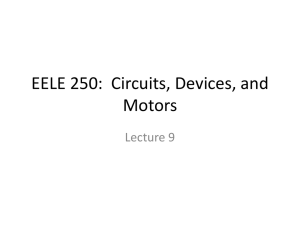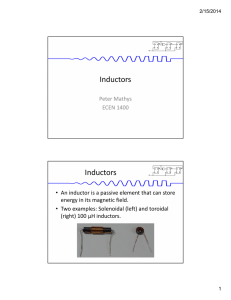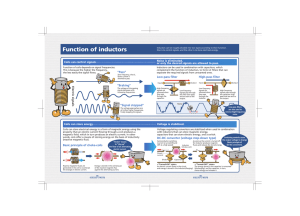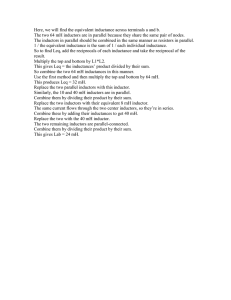Basic Properties of Inductors
advertisement
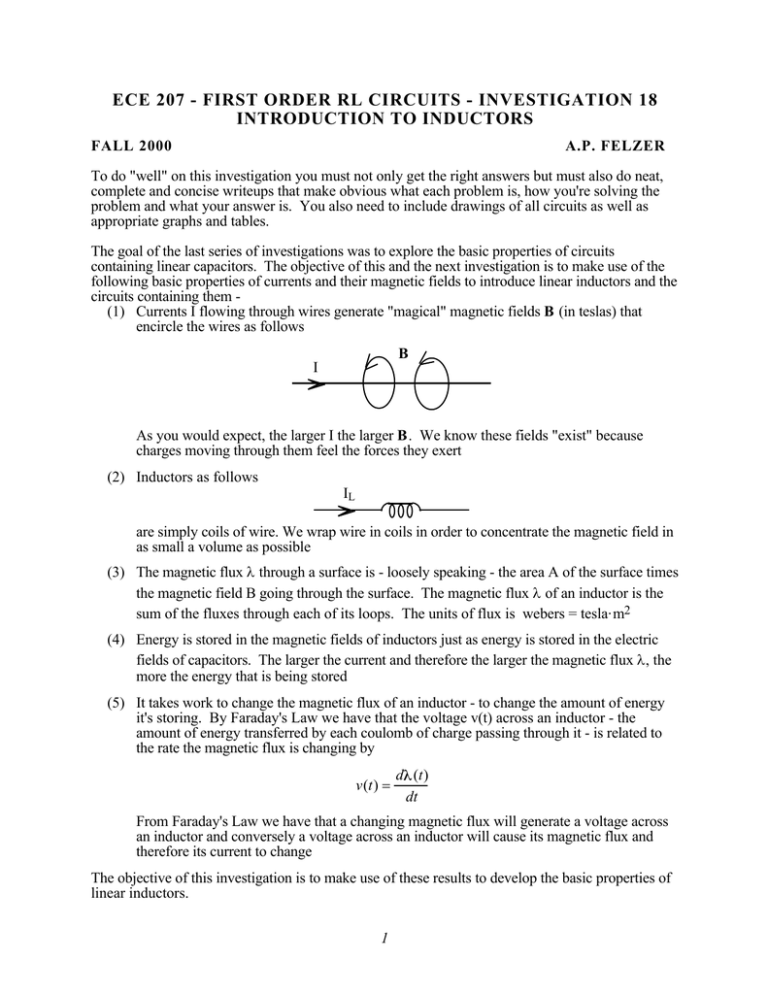
ECE 207 - FIRST ORDER RL CIRCUITS - INVESTIGATION 18 INTRODUCTION TO INDUCTORS FALL 2000 A.P. FELZER To do "well" on this investigation you must not only get the right answers but must also do neat, complete and concise writeups that make obvious what each problem is, how you're solving the problem and what your answer is. You also need to include drawings of all circuits as well as appropriate graphs and tables. The goal of the last series of investigations was to explore the basic properties of circuits containing linear capacitors. The objective of this and the next investigation is to make use of the following basic properties of currents and their magnetic fields to introduce linear inductors and the circuits containing them (1) Currents I flowing through wires generate "magical" magnetic fields B (in teslas) that encircle the wires as follows B I As you would expect, the larger I the larger B. We know these fields "exist" because charges moving through them feel the forces they exert (2) Inductors as follows IL are simply coils of wire. We wrap wire in coils in order to concentrate the magnetic field in as small a volume as possible (3) The magnetic flux λ through a surface is - loosely speaking - the area A of the surface times the magnetic field B going through the surface. The magnetic flux λ of an inductor is the sum of the fluxes through each of its loops. The units of flux is webers = tesla. m2 (4) Energy is stored in the magnetic fields of inductors just as energy is stored in the electric fields of capacitors. The larger the current and therefore the larger the magnetic flux λ, the more the energy that is being stored (5) It takes work to change the magnetic flux of an inductor - to change the amount of energy it's storing. By Faraday's Law we have that the voltage v(t) across an inductor - the amount of energy transferred by each coulomb of charge passing through it - is related to the rate the magnetic flux is changing by v(t) = d (t) dt From Faraday's Law we have that a changing magnetic flux will generate a voltage across an inductor and conversely a voltage across an inductor will cause its magnetic flux and therefore its current to change The objective of this investigation is to make use of these results to develop the basic properties of linear inductors. 1 1. How would you expect an increase in the magnitude of the current through an inductor to affect the magnitude of its magnetic flux λ - would you expect λ to increase, decrease or stay the same. How do you know. 2. The characteristic curves of inductors are graphs that show how λ L varies as a function of IL. Linear inductors, in particular, have characteristic curves as follows λ L (webers) Slope = L IL (amps) with λ L proportional to IL. We refer to L as the inductance of the inductor. a. Find L as a function of λ L and IL b. What will happen to IL if λ L doubles c. What are the units of L 3. Given a linear inductor of value L a. Find L in henrys if λ = 10–6 webers when I = 2 ma. Note that henry is shorthand for webers/amp with 1 weber 1 henry = amp b. What will be the flux λ when I = 5 ma 4. Suppose we have two inductors L1 and L2 with inductances L1 > L2 . a. Sketch their characteristic curves on the same graph b. Which inductor would you expect has the most turns. How do you know 5. The objective of this and the next several problems is to investigate the relationship between vL(t) and iL(t) for inductors. Suppose we have a linear inductor connected to a circuit N as follows iL(t) > 0 + vL(t) – N a. Will vL(t) > 0 cause λ L(t) to increase or decrease. How do you know b. Repeat part (a) for vL(t) < 0 6. Given a linear inductor as follows iL(t) + vL(t) L 2 – a. What is vL(t) when iL(t) is constant. How do you know b. Is the magnitude of vL(t) large or small when iL(t) is changing quickly. How do you know. 7. Given a linear inductor as follows iL(t) + vL(t) – L with L= I ⇒ = LI a. Make use of Faraday's Law d (t) dt to obtain an equation for vL(t) as a function of iL(t) and the inductance L. Memorize this result forever. b. Make use of your result in part (a) to find vL(t) when iL(t) = Io = constant c. Find and sketch vL(t) when L = 0.2 mh and iL(t) = 5 cos (2π106 t - 1.2) ma v L (t) = 8. The objective of this and the next problem is to find equivalent inductors. Given two inductors L1 and L2 connected in series as follows I L1 L2 a. Express the equivalent inductance Leq = λ eq/I in terms of L1 and L2. Hint - make use of the fact that the total flux being stored by the two inductors is λ eq = λ 1 + λ 2 b. How would you make a 4mh inductor from 2 mh inductors. 9. Given two inductors connected in parallel as follows L1 I L2 a. Express the equivalent inductance λ eq = Leq/I in terms of L1 and L2. Hint - make use of the fact that both inductors have the same flux and so λ eq = λ 1 = λ 2 b. How would you make a 5mh inductor from 2 mh inductors. 10. The objective of this and the next problem is to find power and energy for inductors. What we find is that inductors, just like capacitors, store their energies. Suppose, in particular, that we have an inductor with current iL(t) as follows 3 iL(t) and current vL(t) a. b. c. d. Explain in words how you know that vL(t) is the voltage corresponding to iL(t) Sketch the power pL(t) = vL(t)iL(t) How is your curve in part (b) different than power curves for resistors Now sketch the energy EL (t) = ∫ pL (t)dt = ∫ v L (t)iL (t)dt assuming EL(0) = 0 11. Now suppose we have a voltage vL(t) across an inductor as follows iL(t) + vL(t) – L that initially has no flux. Then the energy stored in the magnetic field of the inductor's coil is given by 1 di (t) EL (t) = ∫ pL (t)dt = ∫ v L (t)iL (t)dt = ∫ i L (t) L L dt = LiL2 (t) dt 2 Memorize this result. Then make use of it to a. Sketch EL as a function of iL b. Sketch EL as a function of λ L c. Show that it takes more work to increase the current through an inductor from 1 ma to 2 ma than from 0 ma to 1ma. Why do you think this is so. 12. Sketch v(t) = K1 e −1000t + K 2e −2000t if v(0) < 0 and v'(0) < 0 4


